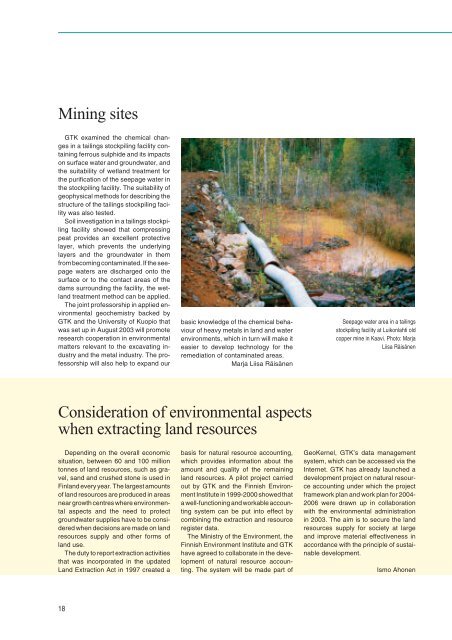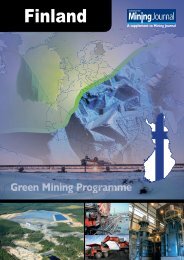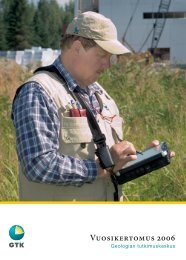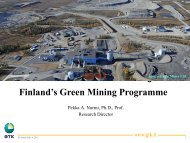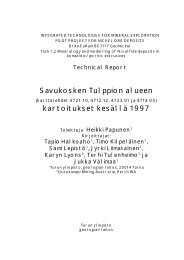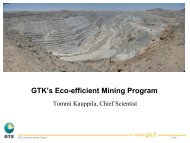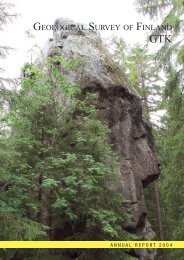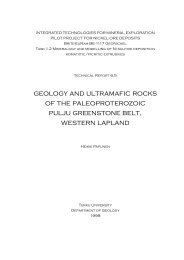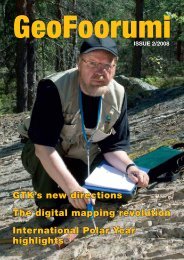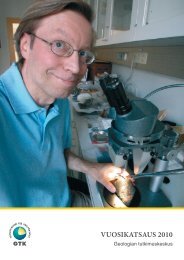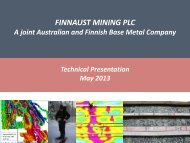Geological Survey of Finland - Geologian tutkimuskeskus
Geological Survey of Finland - Geologian tutkimuskeskus
Geological Survey of Finland - Geologian tutkimuskeskus
You also want an ePaper? Increase the reach of your titles
YUMPU automatically turns print PDFs into web optimized ePapers that Google loves.
Mining sites<br />
GTK examined the chemical changes<br />
in a tailings stockpiling facility containing<br />
ferrous sulphide and its impacts<br />
on surface water and groundwater, and<br />
the suitability <strong>of</strong> wetland treatment for<br />
the purification <strong>of</strong> the seepage water in<br />
the stockpiling facility. The suitability <strong>of</strong><br />
geophysical methods for describing the<br />
structure <strong>of</strong> the tailings stockpiling facility<br />
was also tested.<br />
Soil investigation in a tailings stockpiling<br />
facility showed that compressing<br />
peat provides an excellent protective<br />
layer, which prevents the underlying<br />
layers and the groundwater in them<br />
from becoming contaminated. If the seepage<br />
waters are discharged onto the<br />
surface or to the contact areas <strong>of</strong> the<br />
dams surrounding the facility, the wetland<br />
treatment method can be applied.<br />
The joint pr<strong>of</strong>essorship in applied environmental<br />
geochemistry backed by<br />
GTK and the University <strong>of</strong> Kuopio that<br />
was set up in August 2003 will promote<br />
research cooperation in environmental<br />
matters relevant to the excavating industry<br />
and the metal industry. The pr<strong>of</strong>essorship<br />
will also help to expand our<br />
basic knowledge <strong>of</strong> the chemical behaviour<br />
<strong>of</strong> heavy metals in land and water<br />
environments, which in turn will make it<br />
easier to develop technology for the<br />
remediation <strong>of</strong> contaminated areas.<br />
Marja Liisa Räisänen<br />
Seepage water area in a tailings<br />
stockpiling facility at Luikonlahti old<br />
copper mine in Kaavi. Photo: Marja<br />
Liisa Räisänen<br />
Consideration <strong>of</strong> environmental aspects<br />
when extracting land resources<br />
Depending on the overall economic<br />
situation, between 60 and 100 million<br />
tonnes <strong>of</strong> land resources, such as gravel,<br />
sand and crushed stone is used in<br />
<strong>Finland</strong> every year. The largest amounts<br />
<strong>of</strong> land resources are produced in areas<br />
near growth centres where environmental<br />
aspects and the need to protect<br />
groundwater supplies have to be considered<br />
when decisions are made on land<br />
resources supply and other forms <strong>of</strong><br />
land use.<br />
The duty to report extraction activities<br />
that was incorporated in the updated<br />
Land Extraction Act in 1997 created a<br />
basis for natural resource accounting,<br />
which provides information about the<br />
amount and quality <strong>of</strong> the remaining<br />
land resources. A pilot project carried<br />
out by GTK and the Finnish Environment<br />
Institute in 1999-2000 showed that<br />
a well-functioning and workable accounting<br />
system can be put into effect by<br />
combining the extraction and resource<br />
register data.<br />
The Ministry <strong>of</strong> the Environment, the<br />
Finnish Environment Institute and GTK<br />
have agreed to collaborate in the development<br />
<strong>of</strong> natural resource accounting.<br />
The system will be made part <strong>of</strong><br />
GeoKernel, GTK’s data management<br />
system, which can be accessed via the<br />
Internet. GTK has already launched a<br />
development project on natural resource<br />
accounting under which the project<br />
framework plan and work plan for 2004-<br />
2006 were drawn up in collaboration<br />
with the environmental administration<br />
in 2003. The aim is to secure the land<br />
resources supply for society at large<br />
and improve material effectiveness in<br />
accordance with the principle <strong>of</strong> sustainable<br />
development.<br />
Ismo Ahonen<br />
18


